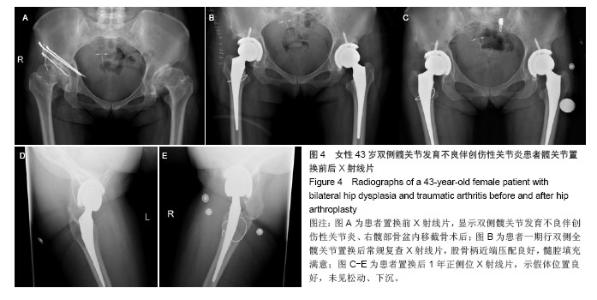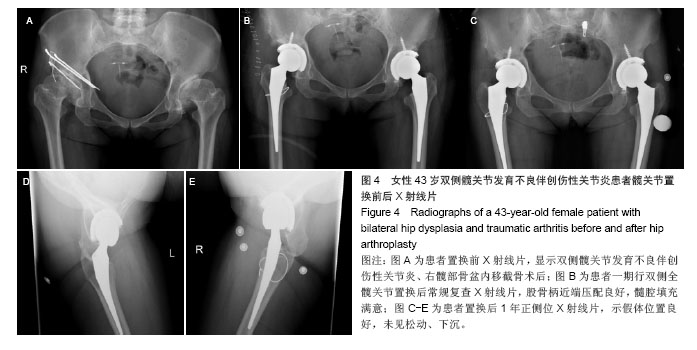| [1]Learmonth ID, Young C, Rorabeck C. The operation of the century: total hip replacement. Lancet. 2007;370(9597): 1508-1519.
[2]Geesink RG. Osteoconductive coatings for total joint arthroplasty. Clin Orthop Relat Res. 2002;(395):53-65.
[3]Capello WN,D’Antonio JA,Feinberg JR, et al.Ten-year results with hydroxyapatite-coated total hip femoral components in patients less than fifty years old. Aconcise follow-up of a previous report.J Bone Joint Surg(Am). 2003;85:885-889.
[4]D’Antonio JA,Capello WN,Manley MT,et al.Hydroxyapatite Femoral Stems for Total Hip Arthroplasty: 10-to 13-Year Followup.Clin Orthop. 2001;(393):101-111.
[5]Harris WH,Traumatic arthritis of the hip after dislocation and acetabular fractures:treatment by mold arthroplasty.J Bone Joint Surg(Am).1969;51(4):737-755.
[6]Petersilge WJ, D’Lima DD, Walker RH, et al.Prospective study of 100 consecutive Harris-Galante porous total hip arthroplasties:4-to 8-year followup study. J Arthroptasty. 1997;12(2): 185-193.
[7]Mulliken.BD,Bourne RB,Rorabeck CH,et al. A tapered titanium femoral stem inserted without cement in a total hip arthroplasty. Radiographic evaluation and stability.J Bone Joint Surg Am. 1996;78(8):1214-1225.
[8]Engh CA, Massin P, Suthers KE. Roentgenographic assessment of the biologic fixation of porous-surfaced femoral components. Clin Orthop Relat Res. 1990;(257): 107-128.
[9]孙俊英,唐天驷,洪天禄,等.巨孔全髋股骨头假体的生物学固定与X线表现[J].中华骨科杂志,1997,17(10):607-610.
[10]Gruen TA, McNeice GM, Amstutz HC. Modes off ailme” of cemented stern-type femoral components: a radiographic analysis of loosening. Clin Orthop Relat Res. 1979;(141): 17-27.
[11]Callaghan JJ, Salvati EA, Pellici PM, et al. Results of revision for mechanical failure after cemented total hip replacement, 1979 to 1982: a two to five-year follow-up. J Bone Joint Surg (Am). 1985;67(7): 1074-1085.
[12]Fang C,Chiu KY,Tang WM, Cementless total hip arthroplasty specifically designed for asians: clinical and radiologic results at a mean of 10 years. J Arthroplasty. 2010;25(6):873-879.
[13]Takenaga RK, Callaghan JJ, Bedard NA, et al. Cementless total hip arthroplasty in patients fifty years of age or younger: a minimum ten-year follow-up. J Bone Joint Surg Am. 2012; 94(23):2153-2159.
[14]Vidalain JP. Twenty-year results of the cementless Corail stem.Int Orthop.2011;35(2):189-194.
[15]Reitman RD,Emerson R. Thirteen year results of total hip arthroplasty using a tapered titanium femoral component inserted without cementin patients with type C bone. J Arthroplasty. 2003;18(7 Suppl 1):116-121.
[16]Teloken MA, Bissett G, Hozack WJ, et al. Ten to fifteen-year follow-up after total hip arthroplasty with a tapered cobalt-chromium femoral component (tri-lock) inserted without cement. J Bone Joint Surg Am. 2002;84-A(12): 2140-2144.
[17]Cruz-Pardos A, Garcia-Cimbrelo E.The Harris-Galante total hip arthroplasty: a minimum 8-year follow-up study. J Arthroplasty. 2001;16(5):586-597.
[18]Burkart BC, Bourne RB, Rorabeck CH, et al. Thigh pain in cementless total hip arthroplasty. A comparison of two systems at 2 years' follow-up. Orthop Clin North Am. 1993; 24(4):645-653. |

